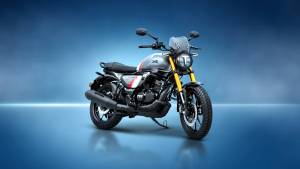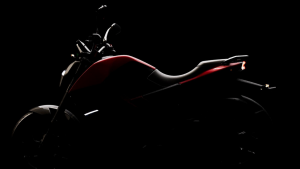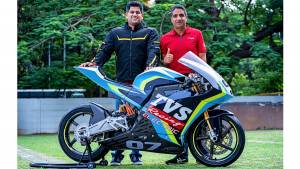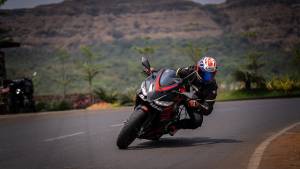2018 TVS Apache RTR 160 4V first ride review
TVS Motor is certainly on a roll. It's just three months since the brand launched its new flagship motorcycle, the Apache RR 310 and just one month since the all-new Ntorq 125 scooter was launched. And now we have an all-new Apache RTR 160. The RTR 160 needs no introduction as TVS Motor's best-selling premium motorcycle and has sold in heaps, enjoying immense popularity as an entry-level performance motorcycle. And now, over a decade after the launch of the original RTR 160, we have an all-new version. The RTR series has always been about frantic performance and razor sharp handling, so can the new one push the envelope further in the 160cc segment? We thrashed the carbureted and fuel injected versions both around TVS Motor's test track at its Hosur plant in Chennai to find out. But first, let's see what has changed.
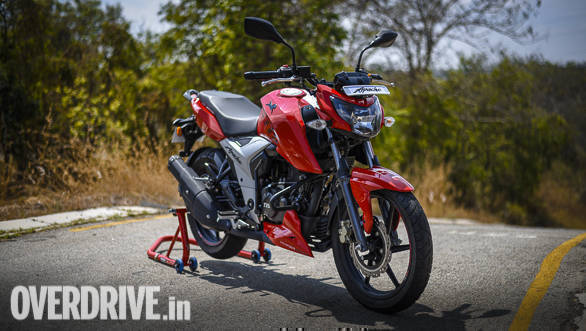 The new TVS's styling is based on the RTR 200 and looks sharper and sleeker than before
The new TVS's styling is based on the RTR 200 and looks sharper and sleeker than before
The design
Expectedly, the new RTR 160's design is based on the Apache RTR 200 4V. Effectively TVS has gotten rid of the earlier bike's bikini fairing and plonked the RTR 200's curvier headlamp unit instead, which also integrates LED daytime running lamps. The clocks sit above the headlamp unit and the face looks a lot more compact than the outgoing version's. The fuel tank is the same as the RTR 200 as well and is sharper looking with its integrated tank extensions. The seat is a one-piece unit unlike the 200's split seats though and the rear cowl is different as well. The LED tail light and double barrel exhaust are again borrowed from the RTR 200 and they do look nice.
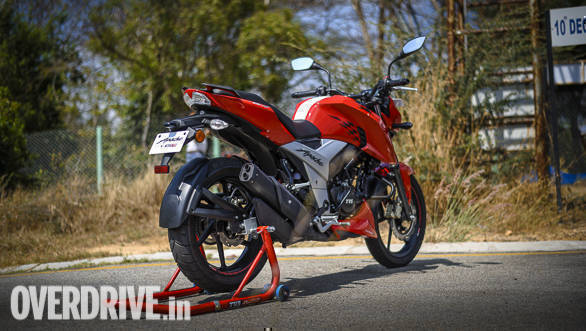 The double barrel exhaust on the new Apache RTR 160 looks a lot more modern than the older bike's unit
The double barrel exhaust on the new Apache RTR 160 looks a lot more modern than the older bike's unit
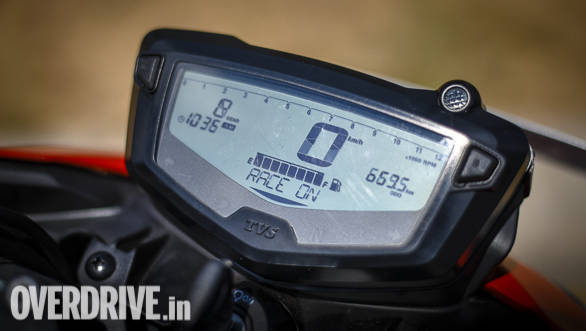 The new instrument cluster on the Apache RTR 160 is straight from the RTR 200
The new instrument cluster on the Apache RTR 160 is straight from the RTR 200
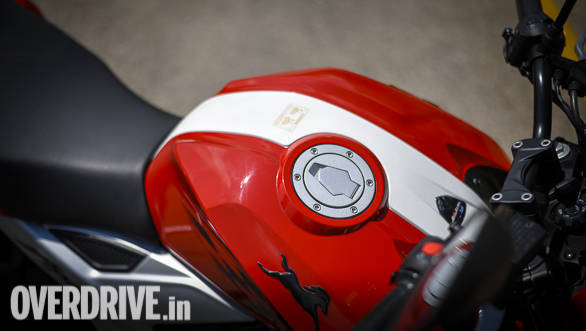 Fit-finish levels and paint quality on the 2018 TVS Apache RTR 160 are top notch
Fit-finish levels and paint quality on the 2018 TVS Apache RTR 160 are top notch
The base carbureted version with a front disc only sports a 110-section rear tyre though the carbureted version (and the fuel injected version as well) with a rear disc as well sports a 130-section rear tyre, which makes for a beefier look. One important change on the ergonomics front is the single-piece handlebar that has replaced the older bike's clip-ons. The RTR 160 also gets the RTR 200's fully-digital dash that's not only nice to look at but offers a plethora of information as well. The instrument cluster gets an amber backlight on the carbureted version while the FI version gets a white now to distinguish the two apart. On the whole fit-finish, quality of plastics and paint quality are top notch and I have no doubt in saying TVS Motor has made a habit of offering best possible finish levels across its product portfolio.
 The 2018 Apache RTR 160's engine feels smoother and more refined than before, thanks to TVS Motor's learnings from its racing program
The 2018 Apache RTR 160's engine feels smoother and more refined than before, thanks to TVS Motor's learnings from its racing program
The engine
The highlight here is the adoption of RTR 200's 4-valve technology. Displacement is the same at 159.7cc, but TVS Motor claims improvements to the engine have been made using its learning from its 165cc race bike that is a regular winner in the national racing championship. TVS Motor has thus managed to eke out more power from the engine and outputs now stand at 16.5PS for the carbureted version and 16.8PS for the fuel injected version (up from 15.12PS earlier). Peak torque produced is up to 14.8Nm now from 13.03Nm and TVS Motor claims the new RTR 160 boasts the best in class power to weight ratio now. Another major highlight is the new found refinement at idle the bike sounds and feels a lot smoother now. The first thing to notice obviously is the improvement in performance the new Apache RTR 160 feels quicker off the line while delivering a stronger punch throughout its rev range. There's a tangible feel to the improvement in performance as throttle opening result in better acceleration than what I remember of the old RTR 160.
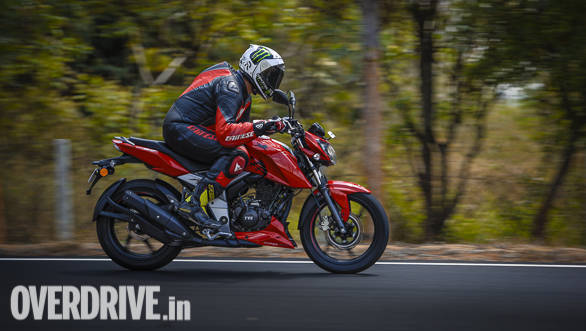 Straightline acceleration on the new Apache RTR 160 is better than before as the power and torque outputs are both up from the older bike
Straightline acceleration on the new Apache RTR 160 is better than before as the power and torque outputs are both up from the older bike
We rode the carbureted and fuel injected versions both and there's a noticeable difference between both in terms of feel. The fuel injected motor felt even smoother, while the exhaust note, at idle at least, is slightly different as well. Throttle response on the fuel injected version is smoother and crisper too though. TVS Motor is claiming a 0-60kmph time of 4.73 seconds which is pretty quick for a 160. I particularly liked the midrange punch from the engine the test track at Hosur has just one sweeping right hand corner and the drive out of the corner even in fifth gear was impressive. On the whole the improvements in performance should help the new RTR 160 feel quicker in traffic the gear ratios have always been spaced well but with more thrust from the engine in-gear acceleration should be even better now.
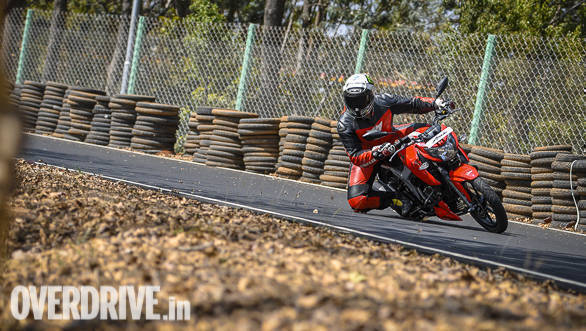 The RTR 200's swingarm and monoshock suspension help the new Apache RTR 160 feel a lot more confident and planted when leaned over fully around corners
The RTR 200's swingarm and monoshock suspension help the new Apache RTR 160 feel a lot more confident and planted when leaned over fully around corners
The chassis
This is where TVS Motor has put in the most effort. The new RTR 160's chassis is inspired from its race bike, the 165cc GP Proto as it calls it. One of the most successful race machines in the country, the bike has won several championships for TVS Motor and the learnings are certainly immense. Another major change on the chassis front is the new monoshock suspension and the RTR 200's swingarm. The suspension on the new RTR 160 has been tuned jointly by TVS Racing's own racers, most being national champions, and engineers from Showa. These are significant upgrades for the RTR 160 and the effect is a far more confident handling package. The changes to the chassis and rear suspension have made the RTR 160 quicker to tip into corners as I found out at the lone curve at the track. I was able to carry speeds of around 90-95kmph into the corner, accelerating through it thanks to the planted feel.
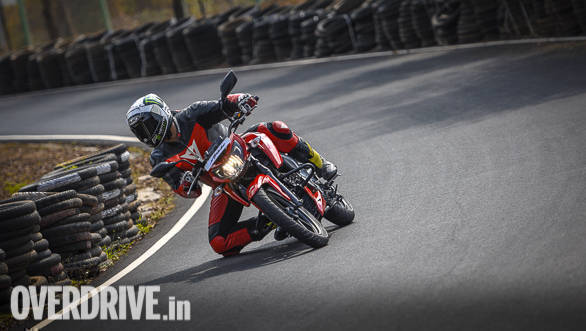 The new Apache RTR 160 feels quicker to turn into corners now as the chassis is inspired from TVS Racing's 165cc race machine that has won several national championships
The new Apache RTR 160 feels quicker to turn into corners now as the chassis is inspired from TVS Racing's 165cc race machine that has won several national championships
The corner in fact has one rather famous dip which has gotten smoother over the years, but is still noticeable when going flat out. The RTR 160 stayed unfazed going over it and I was able to keep the throttle pinned in fifth gear throughout the curve. The experience speaks volumes about the improvements in terms of handling and having done the exact same thing lap after lap at the test track I'm convinced the new RTR 160 will be a far better handler. More importantly, the new RTR 160 feels very forgiving in nature and should make for a friendly motorcycle that won't scare inexperienced riders. I was also impressed with how pliant the suspension setup is I tried going over the speed breakers just outside the test track and the bike seemed to soak it all in. In a nutshell, the new Apache RTR 160 is a significant improvement over its well-acclaimed predecessor.
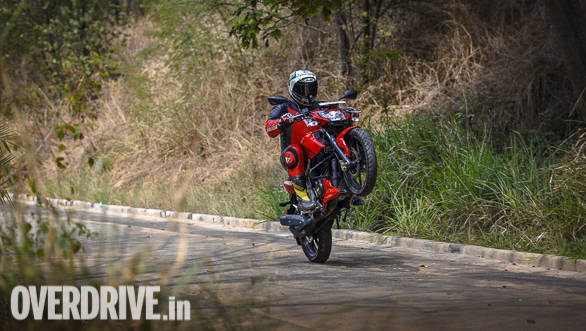 The new Apache RTR 160 continues to be the hooligan it is known to be with its frantic performance
The new Apache RTR 160 continues to be the hooligan it is known to be with its frantic performance
First impressions
The Apache RTR 160 has always been a likeable entry-level performance motorcycle with its kind of frantic performance and sporty handling and the new bike only takes the game a notch higher. The engine feels more refined and more powerful, throughout its rev range. The RTR 200's swingarm and monoshock suspension along with the new, racebike-inspired chassis have clearly helped it become a better handling motorcycle the bike feels sportier, more confident while not trading its friendly, forgiving feel. On the whole the 2018 Apache RTR 160 is a huge upgrade over its predecessor and a motorcycle that promises to up the performance and dynamics game in the 160cc segment. As far as the competition is concerned, the new Apache RTR 160 will take on the likes of the Bajaj Pulsar NS 160, the Honda CB Hornet 160R, the Honda X-Blade that was launched at the 2018 Auto Expo as also the Yamaha FZ-S.
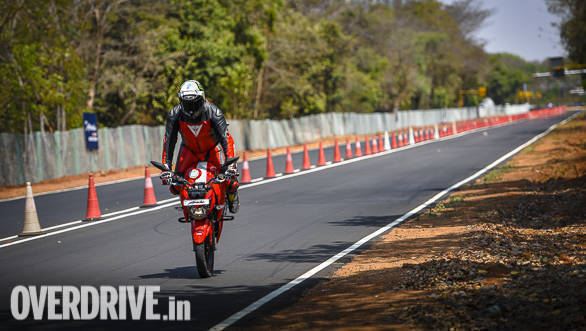 Just like its predecessor, the new Apache RTR 160 is a lot of fun for antics like these
Just like its predecessor, the new Apache RTR 160 is a lot of fun for antics like these
Pricing for the new Apache RTR 160 begins at Rs 81,490 ex-showroom New Delhi for the base carbureted version with a front disc only, while the carbureted version with discs at both ends is priced at Rs 84,490. The fully-loaded, fuel injected version is priced at Rs 89,990. Pricing is on the higher side for a 160cc motorcycle, but when you put into perspective the overall build quality, fit-finish levels you know the new RTR 160 truly is a premium motorcycle. Add to that the higher performance levels and significantly improved handling package and the new Apache RTR 160 justifies the premium it commands over the outgoing version. So if in the market for an entry-level performance motorcycle, the 2018 Apache RTR 160 should certainly feature on your shopping list.
Photography by Anis Shaikh
2018 TVS Apache RTR 160 4V video review:
Starts Rs 79,370
160cc
5-Speed
15.53
13.90
-NA-
Starts Rs 99,950
160cc
5-Speed
16.02
14.12
-NA-
Starts Rs 1,06,687
163cc
5-Speed
14.10
14.70
-NA-
Starts Rs 1,02,700
149cc
5-Speed
12.40
13.60
-NA-
Starts Rs 83,042
149cc
5-Speed
12.40
13.60
-NA-
Related Stories
Top Stories
Latest Videos
Most Popular
- Budget Sportbike Showdown: Kawasaki Ninja 500 vs Aprilia RS 457 vs Yamaha YZF-R3
- 2014 Triumph Daytona 675 vs 2024 Kawasaki ZX6R - A Decade of Evolution in Supersport Motorcycles
- Mumbai-Pune Expressway speed restrictions updated
- 2024 Hyundai Creta vs Toyota Urban Cruiser Hyryder vs Skoda Kushaq comparison review - the hype is real?
- Nissan Magnite EZ-Shift review - is the AMT any good?
